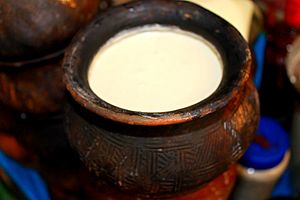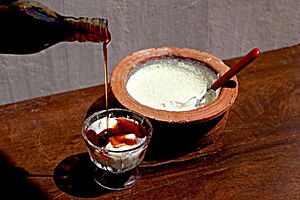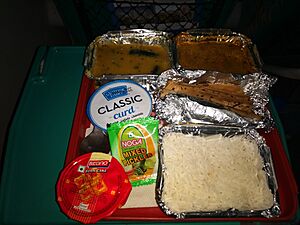Curd (India) facts for kids

Curd in a traditional Manipuri earthen pot
|
|
| Alternative names | Dahi, doi, mosaru, perugu, thayir, mee kiri |
|---|---|
| Course | Homemade yogurt |
| Place of origin | Indian subcontinent |
| Region or state | South Asia |
| Associated national cuisine | Bangladesh, India, Pakistan Nepal, Sri Lanka |
| Main ingredients | Milk, Lactobacillus culture |
| Ingredients generally used | Sugar |
| Variations | Mishti doi, Nabadwip-er lal doi, Dhau |
Curd, also called dahi, is a traditional dairy product from the Indian subcontinent. It's a type of yogurt or fermented milk product. People usually make it from cow's milk, but sometimes from buffalo milk or goat milk. Curd is very popular across the Indian subcontinent.
In Indian English, "curd" means homemade yogurt that has natural good bacteria. The word "yogurt" often refers to the kind you buy in stores, which has been treated with heat.
How Curd is Made
Curd is made by a process called fermentation. This is when tiny living things, called microorganisms, change milk. They turn the lactose (a type of sugar in milk) into lactic acid. This acid makes the milk thick and gives curd its special taste.
Many different types of good bacteria can help make curd. These include Lactococcus lactis and Streptococcus thermophilus. The exact type of bacteria depends on the temperature and moisture in the air.
To start making curd, you often use a small amount of old curd. This is called a "starter." Sometimes, people even use dried red chillies or their stems in warm milk. This is because chillies have some of the good bacteria needed for fermentation.
First, milk is boiled and then left to cool down. When it's warm, but not hot, you add the starter. This could be a spoonful of old curd mixed with its watery part, or even the chillies. Then, the bowl is left in a warm place for about 5 to 10 hours. During this time, the bacteria get to work, turning the milk into curd.
You can also make curd from other milks, like soy milk, using a similar method.
Different Kinds of Curd
Buffalo Curd
Buffalo curd is a traditional type of yogurt made from water buffalo milk. It's very popular in the Indian subcontinent. Buffalo milk is often preferred for making curd because it has more fat. This extra fat makes the curd thicker and creamier.
Buffalo curd is also made by bacterial fermentation, just like curd from cow's milk. The same types of tiny organisms help turn the milk into curd. Buffalo milk has more protein, fat, lactose, minerals, and vitamins than cow's milk. The quality of the curd depends a lot on the starter used.
Traditionally, buffalo curd is made by filtering and boiling the milk. After it cools, a few spoonfuls of old curd are added. This mixture is then poured into clay pots. These pots are sealed and left for about 12 hours to let the curd form.
Yummy Curd Dishes
Curd is a very important part of daily meals in the Indian subcontinent. People enjoy it in both slow-cooked dishes and quick snacks.
- Cooked Dishes
- Curd rice: A simple and comforting dish made with rice and curd.
- Dahi kadhi: A curry made with curd.
- Doi maach: Fish cooked in a curd curry, popular in Bengal.
- Dahi baigan: Eggplant mixed with curd, a South Indian dish.
- Kadhi bari: A curd curry popular in Northern India and Nepal.
- Perugu Pachadi: A dip made with curd, from Andhra Pradesh.
- Thepla: A flatbread often served with plain curd, from Gujarat.
- Fast Food & Snacks

- Dahi vada / Dahi bhalla: Soft fried lentil balls soaked in curd.
- Dahi chiura: Curd mixed with flattened rice, sugar, and sometimes fruit. It's a snack from Nepal and Bihar.
- Lassi: A popular drink made by blending curd with water and a sweetener like sugar.
- Chaas/Borhani: Curd mixed with water and salt, also known as buttermilk.
- Borhani: A Bangladeshi drink made with curd, coriander, and mint.
- Papri chaat: A tasty street food with crispy fried dough, potatoes, and curd.
- Dahi puri: A version of Panipuri that uses curd instead of tamarind water.
- Dahi bhelpuri: A variation of bhelpuri with curd on top.
- Aloo tikki: Potato patties often served with plain curd on the side.
- Aloo paratha: A stuffed flatbread that goes well with plain curd.
- Mishti doi: A sweet curd dessert from Bengal, made by fermenting milk with sugar or jaggery.
- Raita: A side dish made with curd and vegetables or fruits, often served with biryani.
- Chukauni: A Nepalese side dish made with curd, potatoes, and spices.



